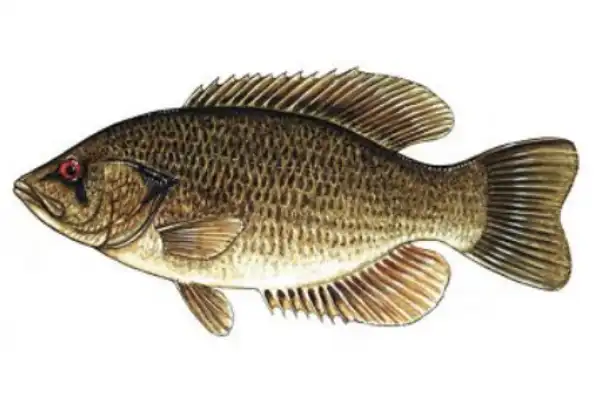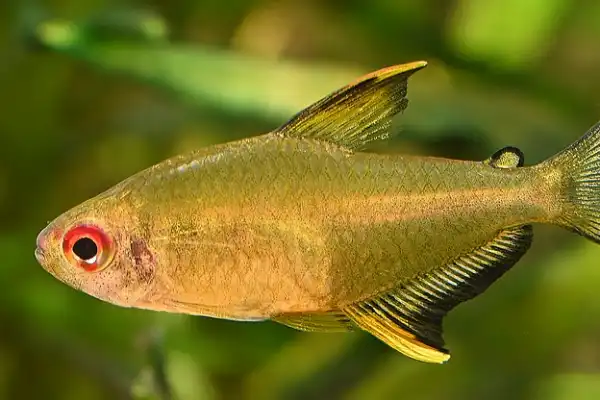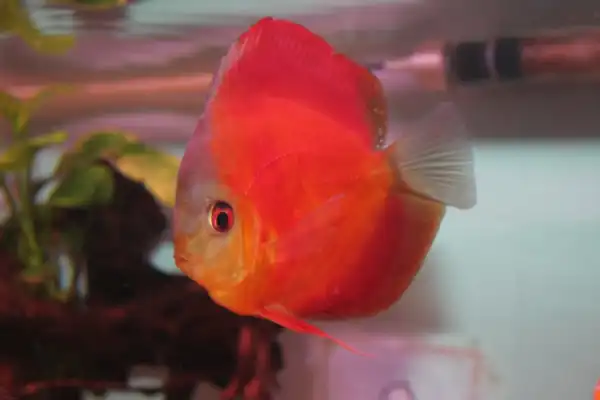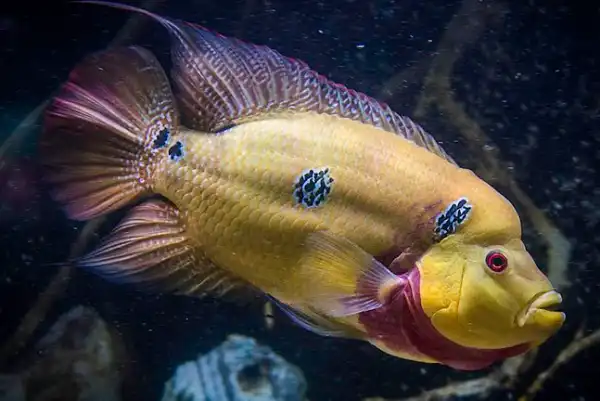Have you ever seen a red-eyed fish? This beautiful earth has a fondness for colors, and a great part of it is covered with a great blue ocean. In this blue ocean, there are many different creatures we can’t even think about. They are such a beautiful creation, and the colors of their beautiful shapes and features are driven by beauty and color. Among them, there are very few species of fish that are believed to have red eyes.
10 Red-Eyed Fish
Normally, we all see eyes of different colors, like black and brown, but what about a fish with red eyes? Yes, a red-eyed fish exists; in reality, let’s have a check over them. Let’s look at some of them and gain a brief knowledge of their physical features and characteristics.
1. Rock bass fish

- Scientific name: Ambloplites rupestris
- Identification: Six spines in the anal fin
- Geographical location: North America, Alabama, Georgia, and Florida
The rock bass, also known as the rock perch, goggle-eye, red eye, and black perch, is a freshwater fish native to east-central North America. It has six spines in the anal fin.
Rock bass have two dorsal fins with spinous and soft-rayed portions, a large mouth, six anal spines, red eyes, and rows of dark dots on their sides.
Their mouth is located below the snout and has small, conical teeth for prey. The largest and most common species, A. rupestris, can reach a maximum length of 43 cm and a weight of 1.4 kg.
They have body colors ranging from golden brown to olive, with a white to silver belly, and can rapidly change color to match their surroundings.
2. Red-eyed tetras
- Scientific name: Moenkhausia sanctaefilomenae
- Identification: yellow band on its caudal peduncle
- Geographical location: Eastern and Central South America.
The redeye tetra is a species of freshwater fish from the São Francisco, upper Paraná, Paraguay, and Uruguay river basins in eastern and central South America.
Do you know this red-eyed fish species is popular as a pet? People like to put it in their aquariums due to its schooling capability, and it can grow up to 7 cm in length.
The fish has a bright silver body, a white-edged black basal half of the tail, and a thin red circle around its eye. Other than that, one more interesting fact you might find amazing is that this species is also famous by the name yellow-banded tetra.
The species got this name because it has a yellow band on its caudal peduncle, distinguishing it from the glass tetra. The bright silver body, black tail, and red eyes give the tetra their name.
3. Lemon tetras

- Scientific name: Hyphessobrycon pulchripinnis
- Identification: Black and yellow marks on anal fins
- Geographical location: South America, Brazil, and the Amazon River
The lemon tetra is a tropical freshwater fish from South America, belonging to the Characidae family. It is a small tetra, growing up to 5 cm in length. It is a deeper-bodied tetra, contrasting with slender, torpedo-shaped relations like the cardinal tetra and the rummy-nosed tetra.
The fish’s basic body color is translucent yellow, with a pearlescent luster from the scales. The dorsal and anal fins are marked with black and yellow, while the tail fin is mostly hyaline.
The lemon tetra’s eye is an intense red, which indicates health. If this color turns gray or starts fading, it means the fish is ill or suffering from a serious disease. Its adipose fin may acquire a black border, enhancing its beauty.
4. Rummy nose tetra
- Scientific name: Petitella bleheri
- Identification: Redhead and eyes
- Geographical location: Brazil and Peru’s Amazon Basin
Petitella bleheri is a silvery characin species found in Brazil and Peru’s Amazon Basin. It has a red head, eyes, and gills, and a horizontal, alternating white and black tail fin.
One of three rummy-nose tetra species, it can reach a standard length of 2 in (5 cm) and is omnivorous, accepting anything offered. Due to its small mouth, it prefers sized foods.
5. Red discus fish

- Scientific name: Symphysodon Discus
- Identification: Compressed body with a discoid shape
- Geographical location: South America
The Red Discus fish, also known as Symphysodon Discus, Pompadour Fish, Heckel Discus Fish, and Symphysodon Heckel, are freshwater bonefish from the Cichlidae family.
They like to live in calm waters and have a compressed body with a discoid shape. Other than that, their livery is variable, with vertical strips or maculatures of various colors.
6. Symphysodon tarzoo
- Scientific name: Symphysodon tarzoo
- Identification: 9 dark vertical stripes on the body
- Geographical location: South America
This species inhabits slow-water areas with abundant vegetation and predators like piranhas. It has a high, round body with compressed sides, a dorsal fin covering the top to the tail fin, a caudal fin like a shovel, and an anal fin extending from the bottom to the ventral fins.
The fish has deep red eyes and nine dark vertical stripes, which are not always visible and run throughout the body. The lifespan is 10 years, and the fish can grow up to 13.7 cm in length.
7. Blue discus fish
- Scientific name: Symphysodon aequifasciatus
- Identification: Horizontal stripes on the whole body
- Geographical location: eastern and central Amazon Basin
Symphysodon aequifasciatus, also known as the blue discus or brown discus, is a cichlid species native to rivers in the eastern and central Amazon Basin.
It is found in black, clear, and white water but prefers lentic habitats like floodplains and flooded forests. It is primarily found in water with a high temperature.
Captive fish can reach up to 23 cm. The fish has red eyes and a body covered with horizontal stripes all over the world.
8. Three-spot cichlid

- Scientific name: Sphaeramia nematoptera
- Identification:
- Geographical location: Mexico and Central America
The next red-eyed fish on our list is the three-spot cichlid, also known as the trimac or red-eyed cichlid. This is a species of cichlid from Mexico and Central America, belonging to the subfamily Cichlasomatinae. It is a large, heavy-bodied cichlid with distinct spots on its sides.
The male is larger than the female, growing up to 15″ and having longer, pointed fins and a large red spot behind his gills. The female is smaller, growing up to 9–10″, and has a less dominant red spot. The male may also grow a nuchal hump when mature.
9. Pajama cardinalfish
- Scientific name: Sphaeramia nematoptera
- Identification: Colorful patterns on the body
- Geographical location: Western Pacific Ocean, Java, Fiji, and Ryukyu Island.
The pajama cardinalfish is also known as spotted cardinalfish, coral cardinalfish, or polkadot cardinalfish. This red-eyed fish weighs around 8.5 cm and displays distinctive red eyes and a broad, dark waistband.
Known for its low vulnerability, it is found in the western Pacific Ocean, from Java to Fiji and the Ryukyu Islands to the Great Barrier Reef.
Despite their bold coloration, pajama cardinalfish have a peaceful nature, blending well into community saltwater aquaria. They form a strict hierarchy in small groups but do not use aggression to exert dominance.
10. Ram cichlid
- Scientific name: Mikrogeophagus ramirezi
- Identification: Blue sheen
- Geographical location: Venezuela and Colombia
The ram cichlid, also known as Mikrogeophagus ramirezi, is a freshwater fish native to the Orinoco River basin in Venezuela and Colombia.
It is a popular aquarium fish and is known by various names, including ram, blue ram, German blue ram, Asian ram, butterfly cichlid, Ramirez’s dwarf cichlid, dwarf butterfly cichlid, and Ramirezi.
Male specimens typically have extended dorsal fin rays, while females have pink or red blushes and a blue sheen. Males are slightly larger, reaching 34–40 mm.
Conclusion:
So these are some of the species of red-eyed fish you can find in the United States and the Pacific Ocean. As science has explored many of the creatures residing on Earth, still a large part is left. No one knows what is there. If you want to explore such a world of animals, then keep looking for it with HowItSee.
Reference:
- Wikipedia
- https://ronsaquatics.files.wordpress.com/2014/03/green-discus-symphysodon-aequifasciatus-_sht.pdf
- http://www.aquascapinglab.com/en/2017/05/12/discus-symphysodon-discus-scheda-tecnica/
Also Read:

As a content writer, I like to write about different niches. I have a curiosity about nature and animals. And like to learn about them. Through my writing, I like to share my experience and knowledge with you. I hope you are enjoying it too.